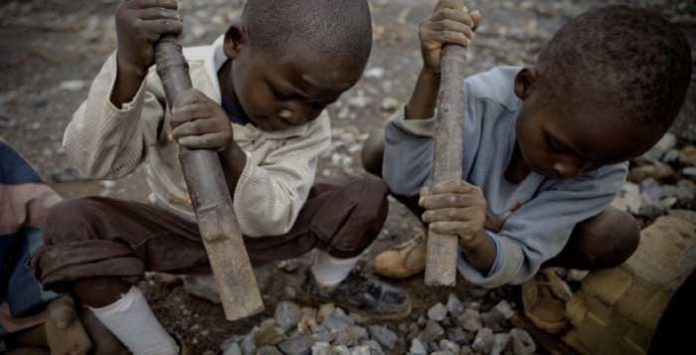This article is written by Tejas Geetey pursuing Diploma in Business Laws for In-House Counsels from LawSikho.
Table of Contents
Introduction
Every enterprise, whether product-based or service-oriented, has been involved in the usage, supply or extraction of minerals. While many industries operate on a uniform basis for extraction, there is part of this sector which is not properly regulated. This unorganised sector comprises artisanal and small-scale mining (hereinafter referred to as “ASM”). ASM workers are involved in the extraction of minerals through low-cost methods. As ASM industries operate on a small scale, many prohibited and illegal activities take place there which include child labour.
Child workers engaging in industries are the most affected as they are directly involved in the extraction of these hazardous minerals. As per the estimation of the International Labour Organisation (ILO) and United Nations Children’s Fund (UNICEF), the number of children engaged in child labour has climbed to 160 million globally, with an increase of 8.4 million in the previous four years, and countless more at danger as a result of COVID-19 [1]. Therefore, to address the situation faced by child workers in these industries, the article is provided with the aim that the business enterprises take some real action to change the already deteriorating situation.
The complex supply mechanism of ASM industries
Artisanal and small-scale mining industries are involved in the extraction of minerals which includes gold, tin, cobalt, coal, and other valuable resources. These minerals are used in almost every commodity of our day-to-day life. From electronic appliances to high-voltage batteries, these minerals are an important component in every day-to-day commodity. ASM comprises about 20% of the global supply of gold, 80% of the supply of sapphire, and 20% of the diamond supply[2]. But despite having an important part in the mining industry, ASM industries to reduce their cost and resources, hire mostly unskilled workers and labourers. The work involved in extracting these high-quality minerals usually involve primitive tools such as shovels, hammers, and buckets.
ASM industries operate on a very complex supply mechanism. From the exploration of the site to acquiring the required tools, and hiring workers for the extraction of work, everything is decentralised and delegated. As the individual output of a worker is much less as compared to the overall requirement, a larger workforce is required and therefore most of the economically backward people, including children below 18 years, involve themselves in these industries so as to sustain themselves and their families.
The ASM industries supply the core primary products to various companies, which are further used in the production of finished goods and services. The lengthy planning process in these mining industries not only involves the extraction of minerals, but also supply management, the formation of contingency plans[3], and labour welfare policies. These complexities led to the rise of many unlawful activities in the sector out of which the most prevalent is child labour.
Health concerns
Children who work in these industries are vulnerable to a number of physical and emotional problems. Child labour jeopardises the education of that child, restricts/limits their future opportunities, and create an unending create cycle of poverty for them. Many international organizations, such as ILO, consider child labour in these industries as the worst form of child labour.
Children working in these hazardous industries face various health issues and infirmities at a young age, which includes brain damage and physical impairment because of exposure to toxic chemicals and gases. From drilling, digging, and extracting the minerals, the children are involved in every process of mining. ILO has conducted various surveys and observed that children are given the same work as adults[4]. Children, at such a tender age, do not have the physical capacity and mental understanding to save themselves from the hazards and therefore it is the responsibility of the employers and the respective state government to restrict such activities.
How to restrict these illegal activities?
The existing regulation of most countries including India has no proper mechanism to identify the unlicensed industries in these small mining industries. As the work involved in ASM industries work on such complex mechanisms, therefore, the relevant data on ASM supply chains is limited, making it impossible to determine whether or not the employers hire child labourers. Due diligence is therefore impossible to perform, as the industries that are formed operate on an informal basis and complex mechanism because of which they vanish after the completion of the projects.
It is therefore important that the accountability and responsibility of regulating these activities are not lost in this process. Businesses involved in the extraction of minerals should set up an internal mechanism to restrict child labourers and enforce effective policies for the same. Additionally, the employers before hiring contractors should have a past assessment of his works and if he/she is involved in any illegal activities. On the regional level, the government should on monthly basis inquire about the activities taking place inside the industries so as to. It is suggested that the business enterprises bring a new global framework to curtail the loopholes generated from these complexities.
In the mapping analysis[5] conducted by the International Law Organisation, it is observed there are common factors that contribute to child labour in ASM industries. These factors include poverty, dearth of skilled opportunities, ineffective public governance, mental anxiety due to the financial condition, limited access to education, negligible support from the employer or business enterprise and lack of awareness of labour welfare rights. It is the need of the hour that the standard of living of unskilled labourers is improved and aim to provide a more robust policy to improve their skills and provide them with better employment opportunities.
Current legislation in India
The Employment of Children Act, 1938 clearly laid down that children under 15 years were not permitted to work in occupations connected with transportation of passengers, goods or mail by railway. The Mines Act, 1952 also provided that persons below the age of 18 shall not be allowed to work in any mine or part thereof and in fact, they are not even allowed to be present in any part of a mine above the ground, where any mining operation is being carried on. Other than these, we have the Act prohibiting and regulating child labour of 1986 which was amended in 2016 which strictly prohibits the engagement of children under 14 years in all occupations and those between 14-18 years in hazardous occupations.
Mining holds a major part in the manufacturing sector of India. India is the third-largest manufacturer of coal and the fourth-largest producer of iron in the financial year 2020[6]. The central government has brought the Mineral Law (Amendment) Act, 2020 which has amended the existing Minerals Act, 1957 and the Coals Mines Act, 2015. This amendment is based to ease the process of licensing approvals, and Aside and provide mining lease to business enterprises and industries. The act aims to build an effective mechanism to promote mining activities and attract potential investors.
Presently, the government has passed the Occupation Safety, health and working Conditions Code, 2020 which shall act as labour welfare and protection for the workers hired in mining industries and docks. It replaces all the previous acts relating to the welfare of labour. The government decision of amending the whole labour code is an important and much-needed step but is not enough to curtail the problem of child labour. It is needed that the government provides some specific regulation for child labourers involved in mining industries. A proper mechanism should be enforced so as to reduce the increasing no. of. child labourers in these industries due to COVID-19.
Conclusion and suggestions
Mining is an unsafe and hazardous activity, and children who are working in these factories are at risk of serious harm and injury. Every year, many innocent children are affected because of the current system in place. The risks are so evident and severe that there should be no reason for acceptance of employment in these industries. ASM industries expose children to a no. of. social, mental, and physical hazards. It is important that the countries take collaborative action to reduce child labour.
The United Nations General has placed greater emphasis on eradicating child labour and has therefore declared this year as the Elimination of Child Labour in all forms around the Globe. The International Labour Organisation (ILO), on June 10, 2021, issued the Global estimates 2020, which observed that the decreasing slope of child labour in the previous years have been reversed. The report observed that almost half of the total children involved in no. of hazardous industries are between 5-11 years old. Therefore, children working in these hazardous industries will be exposed to a lot of unwanted chemicals which might severely affect the health of the child. Additionally, the work environment in these industries is a serious cause of concern. Many children are exposed to people who are involved in unlawful activities such as human trafficking, theft and other criminal activities. The children working in these industries, because of lack of awareness and education, will be induced to work in these unlawful groups thereby worsening the situation.
ILO as well as other international organisations suggest that social as well as financial protection should be provided to children and their families. The government should also initiate various awareness camps that reduce the prevalent upper-lowed caste system in India which leads to ostracization of the many labourers and unskilled workers. The pitiable condition of the labourers in these current times shall only degrade in the coming times. It is, therefore, important the government do something to change this situation and collaborate with other international organisations and countries to reduce child labour.
References
[1]https://www.ilo.org/wcmsp5/groups/public/—ed_norm/—ipec/documents/publication/wcms_797515.pdf
[2] https://www.iisd.org/system/files/publications/igf-asm-global-trends.pdf
[5]https://www.ilo.org/wcmsp5/groups/public/—ed_norm/—ipec/documents/publication/wcms_782888.pdf
[6] https://www.ibef.org/industry/metals-and-mining.aspx
Students of LawSikho courses regularly produce writing assignments and work on practical exercises as a part of their coursework and develop themselves in real-life practical skills.
LawSikho has created a telegram group for exchanging legal knowledge, referrals, and various opportunities. You can click on this link and join:












